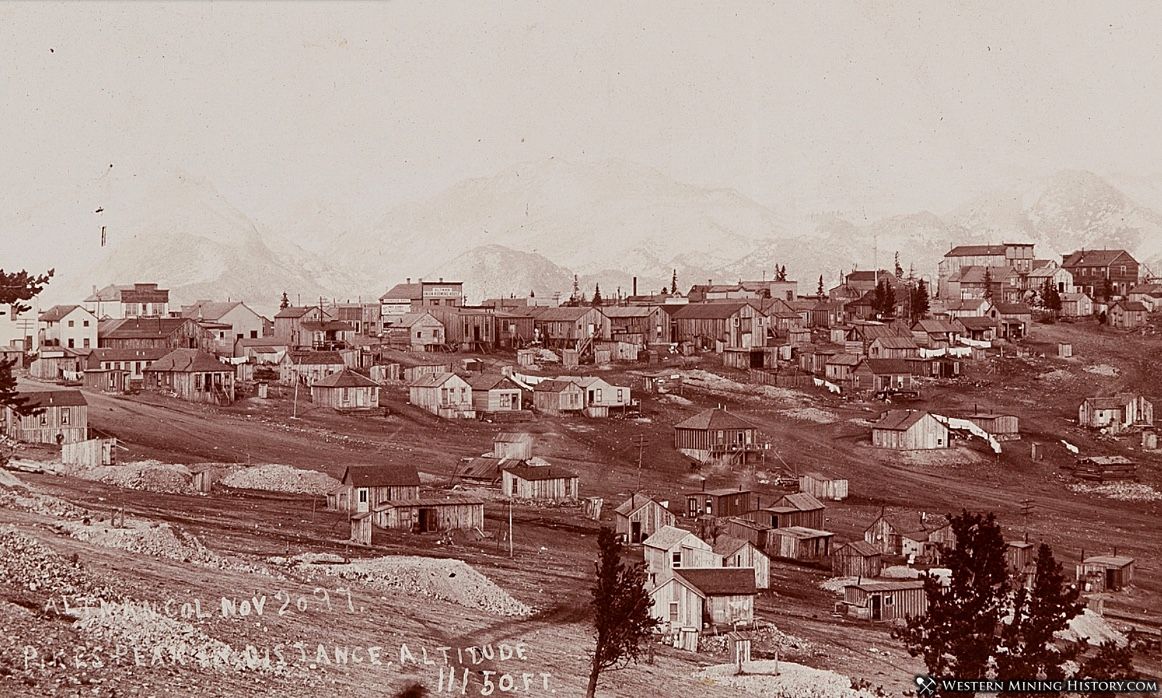writing as Angela Raines
Okay, unless you live in Peru, Tibet or China, most of us don't and probably wouldn't consider living at 14,000 plus feet. In the United States, there are few mountainous areas that even would qualify or have ground enough for living quarters. Those problems didn't stop the Army Signal Corps from giving it a try in the 1870s.
Yes, Colorado had towns at high altitude. Even today the towns of Alma, Blue River, and Leadville are over 10,000' in elevation. In 1894 the town of Altman in the Cripple Creek Mining District had an elevation of 10,630', almost 300' higher than Alma. (Altman sat on the south side of Pikes Peak)
 |
| Altman, CO. from Western Mining History. If you look closely you can see the top of Pikes Peak in the background. |
 |
| Alma, CO 1870 courtesy Wikipedia |
Once, however, established, it's importance as the highest station in the world cannot be overestimated; and its records and observations will be anxiously scanned by the meteorologist of all countries."
Oh, how the thought of having such a place in their own backyard, so to speak, was exciting to this new town, which had been established two years earlier in 1871. They were excited and wanted bragging rights when the wind at the Mt. Washington station in New Hampshire, with an elevation of only 6,288' only about 200' higher than the town of Colorado Springs, reported one-hundred mph winds. Of course, the paper of Sept. 27,1873, had this to say: "The signal Corps report high wind on the peak on Thursday — the highest they have experienced there. The velocity was fifty miles an hour. The signal Corps on Mount Washington have been reporting a wind of one hundred miles an hour, but our boys intend to beat them yet, even if they have to "blow" themselves."
So excited were the citizens arrange a celebration on the peak to begin Oct 11, 1873. The Gazette published the following program in the Oct 4. 1873 issue:
The following program has been arranged for the ceremonies attending the opening of the signal station on the summit of the peak next Saturday.
Friday, — invited parties expecting to attend the dedication of the US Signal Station, will please meet at 8:00 AM at the Colorado Springs hotel. At 9 AM, starting; arriving at the summit at 5 PM. Tea. Ladies to stay on summit — Gentleman at Camp Howgate the S.S. camp near timberline.
Saturday, — Breakfast. Dedication of the building. Presentation of flag. Photographic view of the ceremonies. Dinner. Remainder of the day employed in amusement and conversation. Tea. Ladies remain on the summit — Gentleman at Camp Howgate overnight.
Sunday morning, — start for Colorado Springs, arrived toward evening.
 |
| The photograph shows Albert James Myer, holding binoculars, and another man standing outside a stone observation station on Pikes Peak, Colorado Library of Congress photo. |
Although the sun would shine, there were days when the thermometer told another story. In November 1880 a Mr. F. L. Jones, the signal officer stationed at the peak, said that one Tuesday night was one of the coldest ever experienced by him on the peak. The thermometer showing a minimum of 36° below zero during the entire night and at 5 o'clock yesterday morning it was 31° below.
Two left under clouds of suspicion of fraud, while others simply moved on. Of course, one cannot tell the story of the signal station without mentioning O'Keefe. With the aid of a conspirator in Colorado Springs, O'Keefe told some amazing tales about the top of the peak that were printed worldwide. They even went so far as to stage a funeral and headstone to the child of O'Keefe and his wife lost to the large rats that ate the child. Of course, O'Keefe was a bachelor. I did find an interesting article written years later that tells of death at the station. From Dec. 31, 1933, Gazette, the following information was shared from stories told by the early construction workers.
"All went well at the new station during the first few months of occupation. Following the Christmas holidays, the pair reported 'snowing continuously. Wind blowing a perfect gale.' These reports did not vary from day to day. The monotony and steady grind were upon the boys on the peak. About the middle of January Sgt. O'Leary reported his companion as being a very sick man and growing worse. They had been provided with a medical kit, but nothing so far administered had been of any effect and in the daily reports he grew fearful and apprehensive. Sgt. Lamont called in a well-known physician of Colorado Springs and advised with O'Leary what was best to do. O'Leary grew fearful and called for immediate help, admitting at the same time that no man could live long in the blizzard constantly raging on the mountain. Reports from the peak were discouraging; the stricken man had now developed pneumonia and was rapidly sinking. At 3 o'clock one morning O'Leary called up Lamont and sent a cryptic message,' he is dead.' Little was heard from the peak the days following. O'Leary's hand on the key lack the firm touch of his former self. He was evidently laboring under a great mental strain as his nervous spasmodic touch of the key indicated. When asked what he had done with his companion his brief reply was that he had been buried "military." The story went on to say that they had difficulty getting O'Leary down from the top of the mountain. "The three beef hides were lashed together and he was wrapped in blankets and brought down on an improvised sled. At one point the sick man was shot off the sled but without injury." O'Leary's story ended by saying "O'Leary improved physically and mentally, but never became his former self and shortly afterward died in a federal asylum for the insane."
 |
| Second Summit House/Cog Railway station from Wikipedia |
For those who would like to know more, the early editions of the Gazette and other Colorado Springs publications can be found at Pikes Peak Newsfinder on the PPLD.org website. There is also the book "Weather Pioneers" by Phyllis Smith along with mentions in various older publications found on Google Books and other such sites.
Doris Gardner-McCraw -
Author, Speaker, Historian-specializing in
Colorado and Women's History
Colorado and Women's History
For a list of Angela Raines Books: Here
Photo and Poem: Click Here
Angela Raines FaceBook: Click Here


























